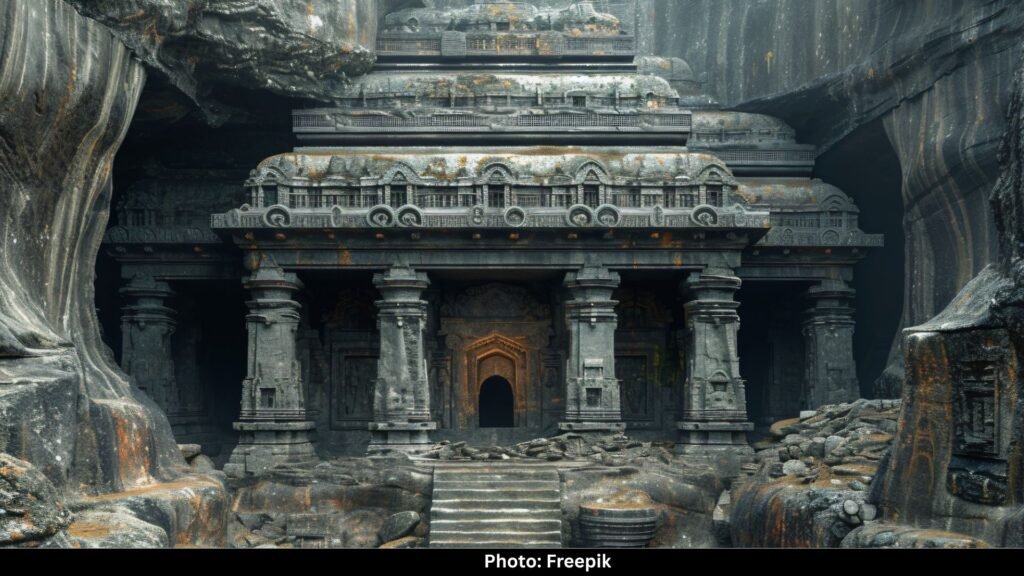Göbekli Tepe: For a long time, archaeologists thought they had the story of civilization more or less straight. People hunted and gathered for tens of thousands of years, then one day they settled down, planted crops, and built permanent homes. Farming gave birth to villages, villages grew into cities, and eventually cities gave rise to religion and monumental architecture.
Then came Göbekli Tepe, a mound in southeastern Turkey that looked like an ordinary hill until someone started digging. What they uncovered didn’t fit the script at all. Here, on a windswept plateau, stood enormous stone circles older than Stonehenge by 6,000 years. Carved pillars, some weighing up to 20 tons, stood arranged in rings, decorated with lions, snakes, vultures, boars, and abstract symbols.
And here’s the thing: the people who built it had no farms, no pottery, no wheels, and no writing. They were supposed to be nomads chasing wild gazelle and picking berries. Yet they somehow came together to build what looks very much like the world’s first temple.
Göbekli Tepe didn’t just add a new chapter to human history. It ripped out the first page and rewrote it.
The Discovery of Göbekli Tepe
The site itself had been known for decades, but no one took it seriously. In the 1960s, a team of surveyors mapped the mound and assumed the scattered stone fragments were just medieval gravestones. They noted it down and moved on.
It wasn’t until 1994 that Klaus Schmidt, a German archaeologist, decided to take a closer look. Schmidt was struck by the shape of the stones and the scatter of flint tools. This wasn’t a graveyard. He began excavations, and within a few years, a picture emerged: massive, carved pillars buried deep within the mound, arranged in great circular enclosures.
Schmidt realized instantly what he was looking at: something built thousands of years earlier than anyone thought possible. He would spend the rest of his life at Göbekli Tepe, calling it the “zero point of history.”
What the Site Looks Like
Imagine standing on a ridge with the Mesopotamian plains stretching below. The ground beneath your feet is littered with limestone fragments, but dig a little, and huge carved stones appear. The most iconic features are the T-shaped pillars, some as tall as 18 feet. Each circle has two giant central pillars surrounded by smaller ones, all linked by low stone walls.
Many of the pillars are carved with reliefs: snarling predators, crawling scorpions, elegant cranes, and human-like arms wrapping around the stone. Some pillars are blank, others are dense with images, as if telling stories in a language no one can read.
And here’s the kicker: these enclosures weren’t one-offs. Beneath the hill are dozens more, still buried. Only a fraction of Göbekli Tepe has been excavated. The site isn’t a single temple—it’s a whole complex, layered over centuries, maybe millennia.
Dating the Impossible
Radiocarbon dating of organic material around the site puts its earliest construction at around 9600 BCE. To put that in perspective, that’s 7,000 years before the Great Pyramid of Giza and 6,000 years before Stonehenge. Woolly mammoths still walked the Earth when people began working on Göbekli Tepe.
This makes it not just old but paradigm-breaking. The prevailing wisdom said that only farming communities could support the kind of organization needed to build monumental architecture. You needed food surpluses, specialists, leadership, and planning.
Yet Göbekli Tepe suggests the opposite. Here, hunter-gatherers organized themselves to haul giant stones, carve them with intricate detail, and arrange them in ceremonial spaces. Civilization didn’t start with farming, then religion. It might have started with religion, then farming.
Who Built It?
That’s the million-dollar question. The builders left no written records, no names carved into the stone, no royal tombs nearby. They were not kings or pharaohs but small bands of hunter-gatherers.
How did they do it? Experiments suggest that with enough people, rolling logs, and ropes, you can move multi-ton stones. But mobilizing that many people requires leadership, coordination, and shared purpose. Why would scattered groups of nomads rally together for such a task?
The most likely answer: belief. Göbekli Tepe looks like a place where rituals happened—maybe feasts, maybe burials, maybe ceremonies that bound communities together. Religion, in this sense, wasn’t a byproduct of civilization. It may have been the spark that made civilization possible.
The Carvings and Symbols
The art of Göbekli Tepe is stunning. Every pillar seems to hold meaning. Lions with bared teeth, coiling snakes, cranes in pairs, foxes slinking across the stone—all carved with skill that suggests not just artisans but storytellers.
What did they mean? No one knows. Some scholars see mythological scenes, others see totems of clans or tribes. A controversial theory argues that the carvings are an astronomical map, recording a comet strike that caused a global climate shift. Another interpretation links the vulture carvings to excarnation rituals—leaving bodies out for birds to strip before burial.
Whatever the meaning, the carvings show symbolic thought, imagination, and cultural depth. These weren’t crude doodles. They were carefully chosen motifs, repeated across different enclosures.
Religion Before Agriculture
The traditional model of human development goes like this: once we domesticated plants and animals, we settled down, formed villages, and had time to invent religion and monuments. Göbekli Tepe flips that logic.
What if people came together first for spiritual reasons? What if the need to gather for ritual created the demand for stable food supplies, which in turn pushed humans toward farming?
Some archaeologists argue exactly that: Göbekli Tepe may have been the birthplace of organized religion, and in the process, it nudged humanity toward agriculture. That’s a staggering thought. Instead of farming enabling temples, temples may have enabled farming.
Why Was It Buried?
Perhaps the strangest twist is that Göbekli Tepe was deliberately buried. Around 8000 BCE, after centuries of use, people filled the enclosures with rubble and soil. This wasn’t natural erosion. It was intentional.
Why would anyone bury their sacred site? No clear answer exists. Some suggest it was ritual closure, a symbolic ending of a spiritual era. Others think environmental changes, like the end of the Ice Age, forced communities to move on. Another idea is social: maybe new generations rejected the old ways and literally covered them up.
Whatever the reason, the burial preserved the site beautifully. The pillars lay hidden for 10,000 years, waiting to be rediscovered.
The Mystery of Its Builders
The people who built Göbekli Tepe vanish from history as suddenly as they appear. We don’t know what they called themselves, what language they spoke, or what stories they told. All we have are their stones.
How did they feed hundreds of workers without farms? Likely through massive hunts and foraging expeditions. Archaeologists have found bones of wild animals nearby, suggesting feasts. Maybe the building itself was part of the ritual—a communal act that bound people together.
And then? The culture disappeared. Did they merge into early farming societies in the Fertile Crescent? Did they scatter and fade? The silence is almost as fascinating as the site itself.
Modern Excavations and Controversies
Since its excavation, Göbekli Tepe has become a sensation. It was declared a UNESCO World Heritage Site in 2018, and tourists now flock to see it. A protective roof covers the main enclosures, and walkways let visitors peer down at the pillars.
But fame brings challenges. Some archaeologists worry about over-interpretation. Klaus Schmidt saw it as a purely ritual site, but newer research suggests people may have lived nearby. Others debate whether it’s accurate to call it “the world’s first temple.” Some prefer to see it as a communal gathering space, not a church in the modern sense.
There’s also tension between preserving the site and opening it up to the public. The more we expose, the more fragile it becomes. And with most of Göbekli Tepe still unexcavated, the biggest discoveries may yet lie underground.
What Göbekli Tepe Really Means for Us
At its core, Göbekli Tepe challenges our assumptions about what it means to be human. We often tell ourselves that survival comes first: food, shelter, stability. Only once those are secured do we bother with art, religion, and imagination.
But Göbekli Tepe suggests the opposite. Long before farming, people were carving visions into stone. They came together to build something that fed their souls before it fed their stomachs.
What this really means is that imagination, myth, and meaning aren’t luxuries. They’re fundamental. They might be the very forces that pushed us to settle down and build the first civilizations.
Conclusion: The Oldest Story We Can’t Read
Göbekli Tepe stands as both a marvel and a mystery. The world’s oldest known temple, built by people who weren’t supposed to be able to build temples, then buried and forgotten for 10,000 years.
We don’t know who its builders were, what they believed, or why they covered their creation in earth. But we know this: they left behind the first great monument to human imagination.
Civilization, it seems, didn’t begin with farming or kings. It began with stories carved into stone, on a hill in Turkey, where the oldest unanswered questions still sit in silence.




